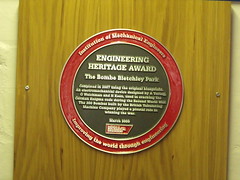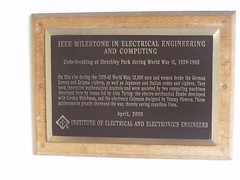The Bombe
Commemorated on 2 plaques
Engineering Heritage Award The Bombe Bletchley Park Completed in 2007 using the original blueprints. An electromechanical device designed by A Turing, G Welchman and H Keen, used in cracking the German Enigma code during the Second World War. The 200 Bombes built by the British Tabulating Machine Company played a pivotal role in winning the war.
Block B - Bletchley Park , Bletchley, United Kingdom where it designed
IEEE Milestone in Electrical Engineering and Computing Code-breaking at Bletchley Park during World War II, 1939-45. On this site during the 1939-45 World War, 12,000 men and women broke the German Lorenz and Enigma ciphers, as well as Japanese and Italian codes and ciphers. They used innovative mathematical analysis and were assisted by two computing machines developed here by teams led by Alan Turing: the electro-mathematical Bombe developed with Gordon Welchman, and the electronic Colossus designed by Tommy Flowers. These achievements greatly shortened the war, thereby saving countless lives.
Bletchley Park House, Bletchley Park, Bletchley, United Kingdom where it designed



